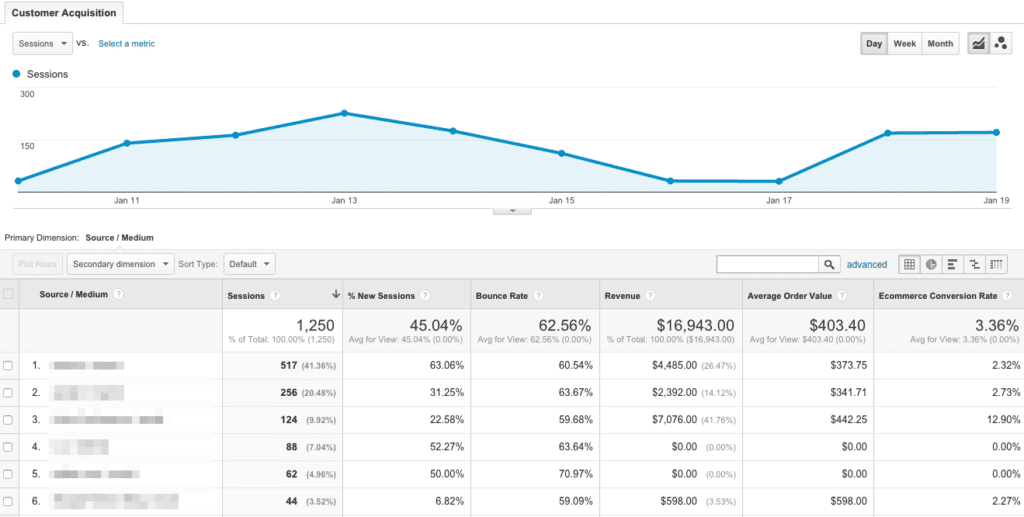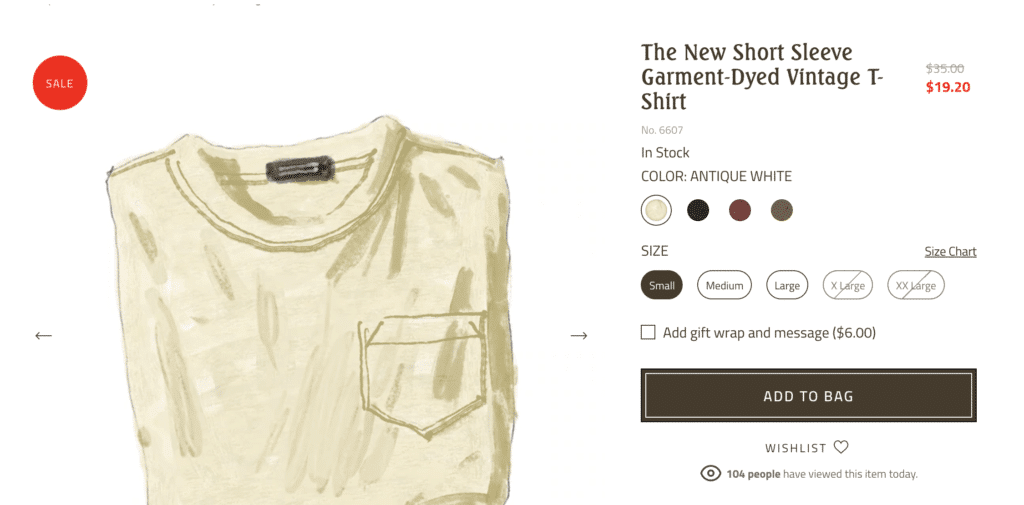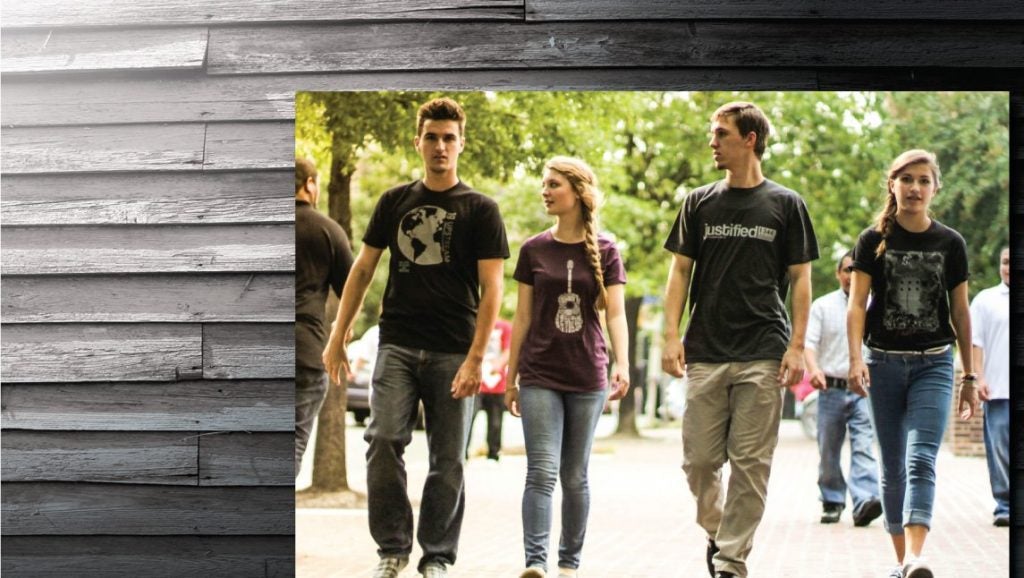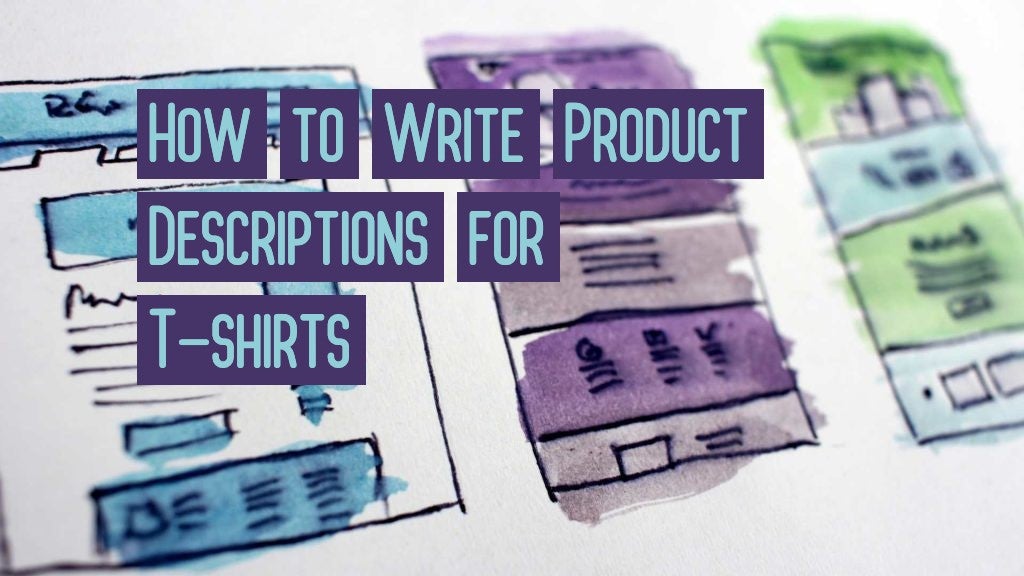How does a T-shirt store owner write great eCommerce product descriptions for their T-shirt and apparel brand?
By creating product descriptions with a customer-centric focus, using a high-quality compelling copy that answers any potential questions about the story behind the design, the type of t-shirt, how the shirt was printed, the fabric, available sizes, and more.
Why does a T-shirt store need more than a few words of general description content on their product pages? User experience is the answer. Relevant, high-quality content helps customers make a decision on your website instead of leaving them with more questions and leaving you without a conversion.
Well-written product descriptions also help eCommerce stores to improve their rank in Google. And that’s for the same reason as above. User experience.
The majority of Google’s top SEO ranking factors are grounded in user experience. The more your customers engage with useful content you are providing them, the more Google will take notice.
Where to Start with T-shirt Product Descriptions
But with so many products and so many pages, where does an online T-shirt store owner start? If you have 100 t-shirts and caps, it takes some time to write unique content for each and every product.
If your site has been around for at least a few months the answer is to use analytics data to determine where the low-hanging fruit is in your online store.

You can use a Customer Acquisition report or the Landing Pages report in your Google Analytics account.
Determine which t-shirt product pages already get the most traffic. It makes sense to start optimizing the descriptions on the highest traffic pages first.
Best Product Page Example
In 1974, long before the word eCommerce was born, a company named Crutchfield was founded. Crutchfield, an electronics retailer widely known for its catalog sales of car stereos, has continued to give customers a wealth of knowledge through its eCommerce website.
Crutchfield is a great example of a brand that fully optimizes their product pages and descriptions.
Their use of product videos, customer Q&A, detailed reviews, high-resolutions product images, surprisingly in-depth overview, detailed section, related articles, and accessories are some of the elements that make Crutchfield’s product pages awesome!
So what does this have to do with T-shirts and apparel brands? Everything. Crutchfield is an example of one industry doing the best job at user experience. As an apparel brand owner, it is your job to find the best way to give your customers the best experience as well.

Crutchfield Car Stereo Product Description
How to Write Your T-shirt Product Descriptions
So how do you use great examples to write your t-shirt product descriptions?
In simple terms, you think outside of the box. Get creative. Think from the customer’s point of view. What makes your t-shirts special? What makes your brand special? What makes your designs special? Let your customers know as much as you can about each design. Use creative, descriptive words, and don’t do ‘just enough’ to describe your products.
If you are selling a drop-ship product from a distributor, then sure, start with the manufacturer description as a bare-bones template. But then copy-edit it. Add to it. Be creative. Stand out from everyone else who sells this product. I know what you’re thinking. How do you make a T-shirt sound compelling?
The answer is it is easy. Use narrative to create your product descriptions and engage your customers.
Best T-shirt Product Description Example
The J. Peterman Company is a great example of a brand that uses a narrative or story to sell their products.
Remember Elaine’s boss on Seinfeld? J. Peterman.

J. Peterman was the eccentric owner of a catalog sales company, who was portrayed by John O’Hurley. The Seinfeld character was based on the real J. Peterman, who owns the J. Peterman Company, which started as a real catalog clothing company.
Let’s take a close look at a vintage J. Peterman product description of a very simple vintage t-shirt. No print. No design. Let’s see how J. Peterman does it.

DETAILS
The New Vintage T-Shirts.
What is this? It looks old.
Well, it’s a vintage T-shirt. It’s new but looks old.
It’s new but looks old?
Well, it seems new, but looks old.
Seems? You mean it really is old?
Well, you know when you’re out buying a couple of steaks and maybe some antifreeze and you decide on a pack of T-shirts at the same time? You mean it’s like that?
Well, it’s like that… but different.
Different?
A lot different.
(Adding to the mystery, the original historic labels were accidentally removed and replaced by our own. Sorry.)
The New Short Sleeve Garment-Dyed Vintage T-Shirt (No. 6607). Garment-dyed 100% cotton slub. One chest pocket (always handy). Noticeably more substantial cotton than you normally find in T-shirts these days, garment-dyed to achieve the effect of great age. Although newborn, they start out looking good (and old). And stay that way. And they don’t disintegrate just at the point when they’re starting to get good. Imported.
The J. Peterman description reads more like a story than a boring t-shirt product description. And J. Peterman has convinced me that this vintage t-shirt may be the best vintage t-shirt in the world. J. Peterman not only sold a lot of products with this epic marketing strategy, but they also built a brand that connects with the customer.
How do you put this into practice on your own website?
Write T-shirt Product Descriptions with the Customer in Mind
Think about the your t-shirt design from the customer’s perspective. Then start writing. Describe the product with all the words that the customer would care about.
Is it made with a special fabric? Will it shrink with 1 wash? Is the design hand-drawn or unique in some way? Is a portion of profits being donated for each shirt? Is the design on the shirt related to a Scripture or Inspirational quote that is well-known?
Include the text on the shirt in the description. Is the design for women? Millennials? College Students? Use words that relate to your target for this shirt. Is there a unique story behind why the shirt was made? Include it.
Describe all the details about the product as if you made it with your bare hands and you are excited about all the features. Let the customer know how great they will feel when they use your product.
The goal is to give the customer as much as they need to make a decision without having to touch the product.
TIP: Once you have the first one completed, move to the next one. If you need help with content, there are some companies that specialize in writing product descriptions.
Don’t expect a content agency to get them perfect. But if someone could write you 100 product descriptions, it would reduce your time invested and allow you to focus on other parts of the business.
Use High Quality T-shirt Photos in your Product Descriptions
While the copy is the best way to drive customers to your pages through search and is the best way to convert them once they get there, with t-shirts your photos are often the secret sauce to the perfect t-shirt product descriptions.
If Perfect Product Descriptions for t-shirts were a coin, then the copy is the ‘Heads’ and photos are the ‘Tails’ of the same coin.
High-resolution, multiple angles & shots, and images that connect with your customer – these are the main components of a high-quality product description photo.
Use as many high-quality images with every angle you can take. Images are one of the most important components of an awesome product description, and so many apparel store owners don’t get this right.
If at all possible, take photos of your apparel in a live setting. In other words, if you sell t-shirts, there’s nothing better than images of people wearing your shirts. Of course, use an image of a person wearing the t-shirt with the view of the front – for your main image.
But then add different angles of people wearing the shirt as additional images. Also, add zoomed-in high-res pics of your t-shirt designs using t-shirt mockups. Add pictures of several people outdoors with your shirts on.
Tip: If you are building a t-shirt brand, don’t just use stock images of people wearing a shirt with the design photoshopped onto the shirt. If you do use photoshopped t-shirt images, please do them well. Not like this one..

If you need to use photoshopped images to get started, that’s fine. But don’t stop there. Take some of your printed shirts out to a college campus. Give them away to students, in exchange for snapping a few photos of them in the gear. Add these to your product pages and your social media channels.
Tip: You don’t have to have the students posing and smiling for the camera in all the pics. Be creative. Let them just talk to each other, lean against a wall on campus, and snap pics of them doing life. The more natural your pics are, the more your customers can connect to the product.
If you are not able to do a photoshoot yet, you can use an app like Placeit.net to create mock images, or search the creative commons database for royalty free images to photoshop your designs onto.
If your target audience is millennials, then the below picture is an example of how to connect with them. If the audience is veterans, then take pics of veterans in your gear.

Write T-shirt Product Descriptions that Improve Conversions
The biggest reason to optimize your product descriptions is that it will help you turn more of your website visitors into sales. Conversions.
If you don’t write compelling product descriptions (and add amazing product photos) of your t-shirts, then you will blend in with the sea of dozens or hundreds of competitors.
If you don’t write compelling descriptions (and add amazing product photos) then you will never convert the maximum amount of your traffic to sales.
And if you don’t write compelling descriptions you can probably forget about your product pages ranking well in Google.
High-quality content engages visitors and improves SEO in so many ways. In fact, about 1/2 of the top 20 (of 200) Google Ranking Factors are related to Content and on-page SEO.
My friend Aaron Orendorff over at Iconicontent uses the tag line “Saving the world from bad content.” And he lives by this creed. His content is next level.
He has consulted many companies to help them improve through quality content. He is also the former editor-in-chief of Shopify Plus, where content is king.
Write SEO Friendly T-shirt Product Descriptions
If you are wondering how many words you should write, there have been industry studies about this. And in the on-page SEO section of this awesome Ecommerce SEO Guide by link building expert Brian Dean.

Dean says you should write 1000+ word product descriptions. Wha??
His exact words are, “The fact is this: Google wants to understand what your page is all about. And the more content you provide, the better Google can do its job. Plus, when you publish long content, customers can better understand what they’re about to buy.
It might be impossible for you to write 1000 words for EVERY page on your site. If that’s the case, I recommend writing long, in-depth descriptions for your 50-100 top-priority product and category pages.”
I agree with him. But I have had success by just writing the product description naturally. Always research what your competitors are doing. If all your competitors are writing 150-word descriptions, then you need to level up. Push yours to at least 250 words each. But remember, it’s all about quality.
And remember, when writing your t-shirt product descriptions, always place yourself in the seat of your customer.
Think of every possible question that a customer might want to know about your t-shirt. And answer all of those questions with great descriptions, and with amazing product photos that show off your designs.
Bryan E. Robinson is the former owner of TshirtGrowth. He has sold t-shirts since 2006 through dropshipping, screen printing, vinyl printing, DTG, Print on Demand, and more. Bryan has created his own t-shirt designs through Photoshop, Canva, and other platforms, as well as worked with freelancers to create many of his designs. Besides t-shirts, Bryan has over 18 years of experience in online marketing with eCommerce, B2B SaaS, B2C products, and more.


